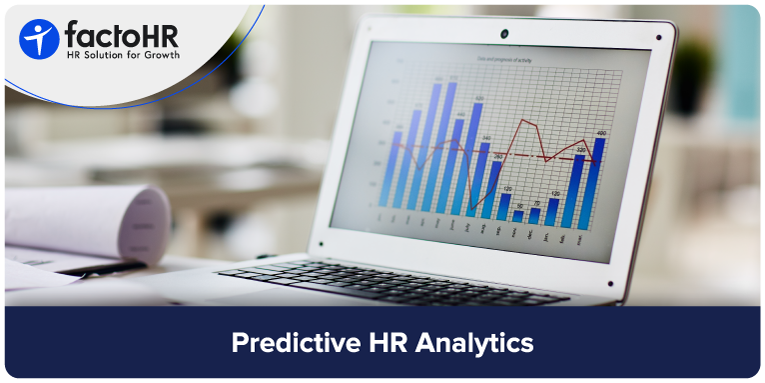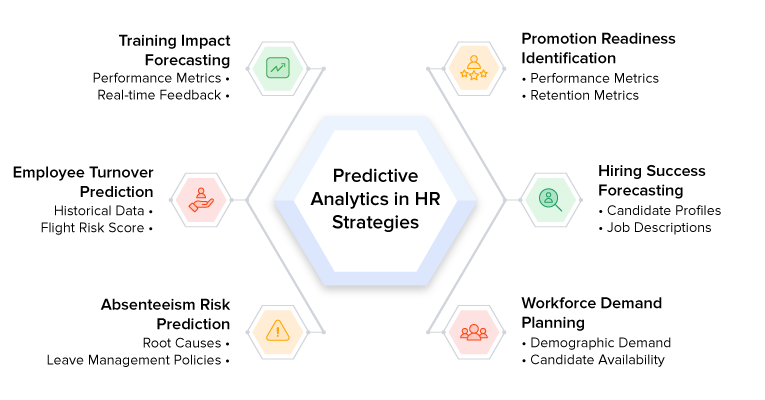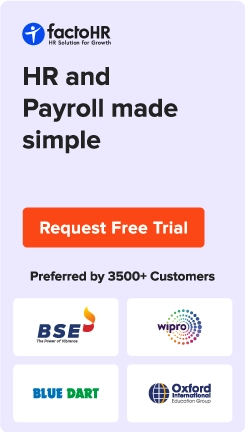Predictive HR Analytics: What it is & How to Use it in 2025

Table of Contents
At a time when data is considered synonymous with decision-making, predictive HR analytics could be the differentiating factor between the failure and success of an organization. According to Deloitte, 74% of organizations consider predictive analytics critical for workforce management, but only 29% have implemented it. This proves that organizations know the significance of predictive HR analytics but are unsure how to implement people analytics for workforce management.
Predictive analytics involves analyzing and extracting historical data, such as turnover rates and performance metrics. In other words, predictive analytics transforms raw data into actionable insights, which are critical for decision-making.
This blog explains the meaning and significance of predictive HR analytics and provides real-life examples of how to implement them in HR management.
What is Predictive HR Analytics?
Predictive HR analytics is a tech tool that combines historical and current data, statistical modeling, and machine learning algorithms to predict future outcomes.
Predictive analysis helps improve employee performance and predict turnover rates. Furthermore, people analytics is important for improving employee engagement. Thus, people analytics can improve productivity and assist in workforce planning. Advanced analytics can also increase employee job satisfaction.

How Predictive HR Analytics Works and Helps to Grow an Organization?
HR analytics include:
- Historical and current data include employee turnover rates, feedback, absenteeism rates, and performance metrics, among other key metrics.
- Statistical modeling encompasses various common frameworks, including decision trees, survival analysis, linear regression, and logistic regression.
- Different statistical models help predict various outcomes. For example, a decision tree could help evaluate employee performance by analyzing several performance and productivity metrics. Similarly, linear regression can help in succession planning by identifying an employee’s readiness for promotion.
- Machine learning: It is a subset of AI that analyzes existing data. It is combined with statistical models to understand the given data better and forecast future trends and patterns.

Benefits of Predictive Analytics for Human Resources
Predictive analysis has several key advantages. It would make the recruitment process more efficient. Similarly, forecasting analytics could also aid in workforce planning. Other benefits include predicting turnover and attrition, improving employee engagement, and reducing costs.
Turnover and Attrition Prediction
It help analyze various metrics such as employee turnover, retention, time-to-fill, and retirement. These metrics are significant, as they address the issues related to flight risks and attrition while preparing your workforce for the future.
Recruitment Optimization
HR managers can also rely on predictive modeling to optimize their recruitment process. It correlates various recruitment analytics, such as cost-per-hire, time-to-hire, and quality of hire. Predictive analytics for recruitment channels, yielding desirable results.
Better Workforce Planning
Forecasting analytics are useful in workforce planning. They interpret several metrics, such as the absenteeism rate, and assess metrics related to skill gaps, training, and development.
Increased Employee Engagement and Productivity
According to McKinsey, employee disengagement costs nearly all organizations around $90 million each year. Predictive intelligence improves employee engagement by dissecting employee recognition, productivity, and satisfaction data.
Cost Reduction through Data-Led Decisions
Predictive HR analytics identifies regular and irregular patterns. People analytics also improves employee retention by interpreting metrics related to retention rates. Thus, advanced analysis of hiring patterns can help reduce recruitment and other HR operations costs.

Predictive Analytics is Optimizing and Enhancing HR Strategies
Let’s look at some real-life examples where firms rely on predictive analytics to improve different HR functions.

Employee Turnover Prediction
Hewlett-Packard (HP) was facing significant issues related to employee turnover. Turnover rates were upwards of 20%. HP reduced the turnover rate to less than 10% by combining historical data and developing a “flight risk score” with the help of predictive HR analytics.
Hiring Success Forecasting:
Amazon developed a predictive model for scanning candidate profiles and matching them with the criteria. This model analyzed the skills, performance, and work experience of the candidate and compared the profile with the job description. As an outcome, Amazon saw a 25% increase in recruitment efficiency.
Absenteeism Risk Prediction
E.ON, a major energy firm in Germany, was experiencing significant employee absenteeism. This resulted in frequent workforce disruptions. Using predictive HR analytics, data professionals hypothesized possible root causes of absenteeism. As a result, the firm identified the lack of enough leaves as the major factor behind absenteeism and implemented effective leave management policies to resolve the issue.
Workforce Demand Planning
While considering a new location for one of its branches, Cisco used predictive analytics to identify the best location for opening its office. It identified key factors such as demographic demand and the possibility of finding new candidates to determine the ideal location.
Training Impact Forecasting
Netflix designs targeted on-the-job training programs by analyzing performance metrics, real-time feedback, and potential areas for improvement.
Promotion Readiness Identification
Google’s people analytics team developed a predictive engine that helps predict the outcomes of various HR operations. One of them is identifying promotion readiness. Google interprets several metrics related to performance and retention and takes preemptive measures to address any potential issues related to succession planning.

How to Implement Predictive HR Analytics?
Here’s a step-by-step guide for implementing predictive analytics in HR management.
- Step one: Collect and prepare HR data. Based on your needs, gather relevant HR data such as cost per hire, employee turnover rates, or performance metrics.
- Step two: Choose or build the right model. You can create a predictive model by combining statistics and machine learning algorithms. You can also choose from a number of popular HR predictive analytics tools to avoid the hassle of building an entirely new model.
- Step three: Validate the model with historical accuracy. Test the model by providing historical data.
- Step four: Integrate the predictive model into the HR workflow. After verifying the accuracy of the predictions, integrate the predictive model into the HR workflow.
- Step five: Monitor, refine, and act. Monitor the current predictions. Refine the model when necessary for more accurate predictions. Most importantly, preventive measures should be taken based on the given predictions.
How do Predictive and Descriptive Analytics Differ?
Predictive and descriptive analytics are two major types of HR analytics.
Predictive analytics uses historical data of the organization to forecast future trends and outcomes based on it. In contrast, predictive analytics simplifies and summarizes existing data to provide insights into the ongoing organizational performance and processes.
There are four major types of HR analytics. This blog provides more information about them.
How to Overcome Common Challenges while Implementing Predictive HR Analytics?
There are three significant challenges while implementing predictive HR analytics, which are:
- Data quality and access,
- Low analytics literacy in HR teams, and
- Privacy and ethical concerns.
Data Quality and Access
Gathering accurate and timely data might be challenging. In such a scenario, opt for an HRIS solution that easily integrates with other modules.
Low Analytics Literacy in HR Teams
To maximize your predictive analytics capabilities, you need a well-trained HR department. Hire data analysts and HR data professionals. Familiarize your HR team with predictive analytics tools to build a future-ready team.
Privacy and Ethical Concerns
If you use non-anonymous employee data, store it on secure cloud centers. Only use employee data after asking for their explicit consent.

Conclusion
Predictive analytics is the future. Successful companies, such as Google, Netflix, and Cisco, have already implemented and developed HR predictive analytics tools to drive organizational growth.
People analytics can improve employee engagement and performance. They can also optimize hiring processes by identifying key patterns between various metrics, such as cost per hire and quality-to-hire ratio.
However, implementing predictive analytics in HR management presents several challenges, including data quality issues, ethical concerns, and a lack of awareness about predictive analytics.
What are the 4 Types of HR Analytics?
The four types of HR analytics include:
- Descriptive analytics: Describes the current problems using historical and current data.
- Predictive analytics: Predicts future outcomes or events based on historical data and observed patterns or trends.
- Diagnostic analytics: Helps diagnose the current issues by identifying correlations between different metrics.
- Prescriptive analytics: Prescribes possible solutions based on past and current data.
What are some Examples of Predictive Analytics?
Some popular examples of predictive analytics in HR management are predicting employee turnover, anticipating future staffing needs, and optimizing the talent acquisition process. Other examples include data-driven performance reviews and promotion readiness identification.
What are the Different Phases of Predictive HR Analytics?
There are seven different phases of predictive HR analytics:
- Defining the HR challenge and aligning it with business goals,
- Collecting data and validating data quality,
- Using visualization tools and identifying correlations between different metrics.
- Applying various statistical models, such as logistic regression and linear regression.
- Test the model’s accuracy on a dataset,
- Predict future outcomes, and
- Implement HR strategies based on the prediction results.
Grow your business with factoHR today
Focus on the significant decision-making tasks, transfer all your common repetitive HR tasks to factoHR and see the things falling into their place.

© 2025 Copyright factoHR


